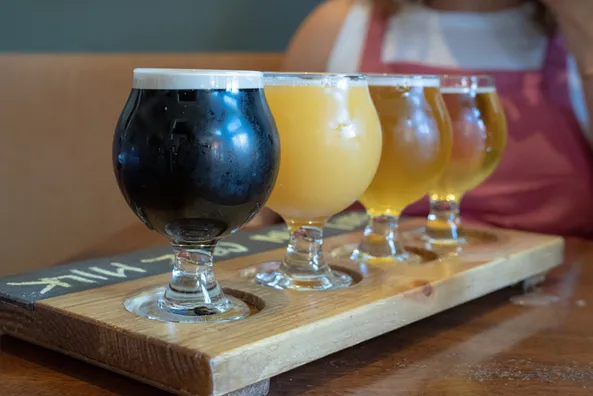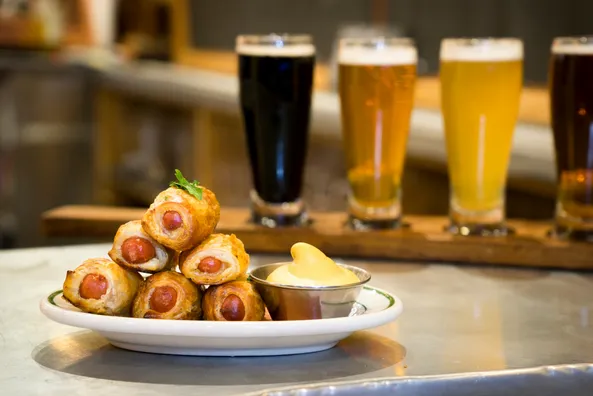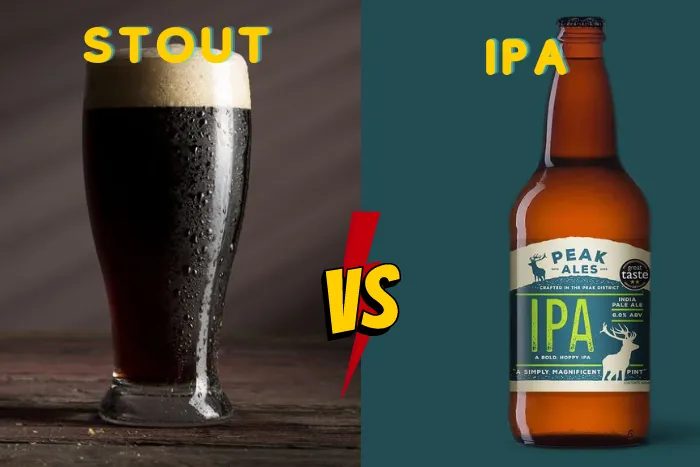Regarding beer, the debate between stout and IPA never ends. From their origins and history to their ingredients, fermentation process, flavor profile, and health impact – there are a lot of differences between these two popular beers. Stout vs. IPA: which one should you choose?
We’ll examine all the significant factors to help you decide which beer type will best meet your preferences. Comparing stouts and IPAs, we will provide a selection of the most popular ones to sample so you can decide which type of beer best suits your tastes.
Table of Contents:
- Origins and History of Stout and IPA Beers
- Ingredients Used in Stout and IPA Beers
- Fermentation and Brewing Processes for Stout and IPA Beers
- Flavor Profile, Color, Alcohol Content, IBU, and Health Impact of Stout and IPA Beers
- Popular Stout & IPA Beers to Try
- FAQs in Relation to Stout vs Ipa
- Conclusion
Origins and History of Stout and IPA Beers

Stouts and IPAs have been around for centuries, but the history of these two popular beer styles is surprisingly intertwined.
Origin of Stout Beer
The origin of stout beer dates back to the 17th century in England, where it was originally called “stout porter” due to its dark color and robust flavor. This style was created by blending three types of ales: brown, mild, and pale. Over time, stouts became darker in color as brewers added more roasted barley or malt to give them a fuller body and richer flavor profile.
Origin of IPA
In the late 18th century, British brewers began shipping their beers to India with an increased hop content for better preservation during long voyages, thus creating what is now known as IPA beer.
It resulted in a stronger-tasting beer with higher alcohol content than traditional English ales – hence the name “India Pale Ale” (IPA). Building on the original style, modern IPAs are often brewed with American hop varieties such as Citra and Mosaic, producing a hoppier beer with distinct tropical fruit flavors.
Stout and IPA beers have a long history that has evolved over time, giving us the delicious styles we know today. Let’s now look into the components utilized to concoct these beloved beer types.
Ingredients Used in Stout and IPA Beers
Stouts and IPAs, two of the most popular beer styles, differ in their ingredients. Commonly used in both stouts and IPAs are malted barley, hops, yeast, and water. Yet, each style can also feature added components to create particular tastes or fragrances.
Common Ingredients Used in Stouts:
Stouts typically use roasted barley or black malt as a base ingredient, giving them a dark color and rich flavor profile. Hops like Fuggles or East Kent Goldings may be used for bitterness, while other varieties, such as Willamette, offer floral notes.
Yeast is usually an ale strain that ferments at cooler temperatures than lagers, creating a creamy texture with hints of chocolate or coffee-like characteristics. Lastly, water is needed for brewing purposes but should not contain too much mineral content; otherwise, it will affect the taste negatively.
Common Ingredients Used in IPAs:
India Pale Ales (IPA) use pale malt as their main ingredient giving it a light golden hue and milder flavor than stouts. Hops like Cascade or Amarillo provide citrusy notes, while Centennial adds earthiness and piney aromas depending on how much is used during the boiling process. As far as yeast goes, IPAs generally use an American Ale strain so that fermentation occurs faster at warmer temperatures resulting in a crisp finish with fruity esters (banana & clove).
Water quality plays an important role here, too, since high levels of minerals can cause off-flavors due to reactions between certain ions found within it, such as calcium chloride, which produces sulfates making beers taste more bitter than intended consumed by human palates over time.
Brewing Processes of Stout

The initial phase of brewing a stout involves fermenting the wort, during which yeast consumes sugars to create alcohol and other flavorful elements while also releasing CO2. During this stage, yeast consumes sugars in the wort, producing alcohol, carbon dioxide, and other flavor compounds. The secondary fermentation stage follows, where additional flavors are developed through oxidation and aging. Stouts typically have a higher ABV than IPAs due to their longer fermentation times.
Brewing Processes of IPA Beers
IPA beers use similar processes as stouts but differ in the type of yeast used during the primary fermentation step. For IPAs, ale yeasts are commonly used, which produce fruity esters that contribute to its unique taste profile. IPA beers also tend to be more heavily hopped than stouts, resulting in an increased bitterness level measured by International Bitterness Units (IBU).
The brewing process for both styles involves boiling malted grains in water, which creates wort – a sugary liquid containing fermentable sugars extracted from grain starches during mashing. After boiling, hops are added, which gives beer its bitter character and aroma, depending on when they’re added during the boil time. Finally, yeast is pitched into cooled wort before it’s transferred into containers for primary or secondary fermentation stages, depending on the style of beer being brewed (stout vs. IPA).
The fermentation and brewing processes for stouts and IPAs are complex. Still, the flavor profile, color, alcohol content, IBU, and health impact of these two styles can also be quite different. Examining those differences in more detail will better understand why each beer is unique.
Stout vs IPA Beers: Flavor Profile, Color, Alcohol Content, and IBU
Stouts and IPAs are two of the most renowned beer varieties globally. Despite having certain resemblances, stouts and IPAs are dissimilar in their flavor characteristics, hue, ABV (alcohol by volume), IBU (International Bitterness Unit) level, and health implications.
Taste Comparison of Stout and IPA Beer
Stouts tend to possess a bold roasted malt taste with hints of coffee or cocoa. They also often have hints of caramel or molasses sweetness and a slight smokiness from smoked malts. IPAs, on the other hand, typically feature an intense hop aroma and flavor that can range from citrusy and fruity to herbal and resinous, depending on the hops used. Both beers can be bitter, but IPAs usually have higher IBUs than stouts.
Color Comparison of Stout and IPA Beer
Stouts have a deep color spectrum, running the gamut from dark browns through jet black, whereas IPAs can vary widely in hue and may range anywhere from golden yellow to rich ambers.
Alcohol Content in Stout and IPA Beer
Concerning alcohol content, while both beer styles may reach elevated ABV levels, stouts usually outrank their IPA counterparts due to their fuller body, allowing for greater sugar fermentation during brewing and, thus, higher ABVs than those found in light-bodied IPAs.
Regarding health benefits, both styles can provide antioxidants depending on how dark they are. Still, generally speaking, stouts will contain more since they usually use roasted grains while making them, whereas lighter-colored beers like pale ales don’t typically use any at all.
Popular Stout & IPA Beers to Try
For those looking to explore these unique brews, here is a list of some popular stouts and IPAs you should try.
Popular Brands of Stout Beers
Guinness Draught is an excellent choice if you’re looking for a classic stout experience. It has a creamy texture with hints of roasted barley and coffee flavors. Another great option is Founders Breakfast Stout which offers notes of chocolate, oats, and coffee in every sip. Finally, if you want something extra special, then The Abyss by Deschutes Brewery might be just what you need; it’s an imperial stout brewed with licorice root, molasses, vanilla beans, and other spices that give it an intense flavor profile.
Popular Brands of IPA Beers
When it comes to IPAs, there are so many choices available, but one of the best ones is Sierra Nevada Torpedo Extra IPA which has a strong hop aroma balanced out by malt sweetness. Another great option is Dogfish Head 60 Minute IPA which features citrusy hops alongside piney bitterness for a refreshingly crisp taste. Lastly, Lagunitas Hop Stoopid Ale offers bold hop flavors blended with sweet caramel malts for an unforgettable experience.
FAQs in Relation to Stout vs IPA
Is stout healthier than IPA?
Stout and IPA beers are both healthy options in moderation. While IPAs tend to have higher alcohol content, they also contain more antioxidants than stouts. Dark malts give stouts a richer flavour and fewer calories, making them healthier if consumed responsibly. Ultimately, the healthiest beer is one that you enjoy drinking without overindulging or consuming too many calories.
What are the 3 major classifications of beer?
Beers are generally classified into lagers, ales, and hybrid beers. Lagers are bottom-fermented beers with a light flavor profile and notes of malt and hops. Ales are top-fermented beers that can range from light to dark in color, with flavors ranging from sweet to bitter. Hybrid beers combine elements of lager and ale brewing techniques resulting in unique flavor profiles not found elsewhere. All three types offer various styles for any craft beer enthusiast.
Why is stout better?
Stout beer has a higher alcohol content than other beers and a dark, full-bodied flavor from roasted barley or malt. It has an intense flavor profile that many people find enjoyable. Its higher alcohol content makes it perfect for winter nights. Stout’s high antioxidant content helps protect against illness and reduce inflammation, making it a beneficial beverage. Lastly, Stout’s unique flavors pair well with steak and chocolate desserts, improving the experience.
Is Guinness a stout or IPA?
Guinness is a stout beer. It is a dark, top-fermented brew with roasted malt notes and hints of coffee or chocolate. Guinness’ flavor is created by the interplay of malted barley, hops, yeast, and H2O during brewing. Its signature creamy head results from nitrogen being added during the carbonation process. Guinness is one of the world’s most popular beers due to its unique flavor and full body.
Conclusion
In conclusion, stout and IPA beers have a variety of differences in terms of origins, ingredients used, fermentation and brewing processes, flavor profile and mouthfeel, color alcohol content IBU (International Bitterness Unit), and health impact. Whether you prefer the more robust taste of stouts or the hoppier flavors associated with IPAs will depend on your individual preferences. Despite the differences between stouts and IPAs, there is still a wide selection of both styles to sample.
Discover the best beer reviews, equipment, and subscription services to make your brew publik experience unforgettable. Learn more about stout vs. IPA and craft a delicious beverage that will satisfy even the most discerning of palates!
Also See: Unlock the Secrets of Craft Beer: A Square Keg Review

